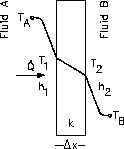CONVECTION HEAT TRANSFER
Heat Transfer
It is the temperature difference at one end of the heat exchanger minus the temperature difference
at the other end of the heat exchanger, divided by the natural logarithm of the ratio of these two
temperature differences. The above definition for LMTD involves two important assumptions:
(1) the fluid specific heats do not vary significantly with temperature, and (2) the convection heat
transfer coefficients are relatively constant throughout the heat exchanger.
Overall Heat Transfer Coefficient
Many of the heat transfer processes encountered in nuclear facilities involve a combination of
both conduction and convection. For example, heat transfer in a steam generator involves
convection from the bulk of the reactor coolant to the steam generator inner tube surface,
conduction through the tube wall, and convection from the outer tube surface to the secondary
side fluid.
In cases of combined heat transfer for a heat exchanger, there are two values for h. There is the
convective heat transfer coefficient (h) for the fluid film inside the tubes and a convective heat
transfer coefficient for the fluid film outside the tubes. The thermal conductivity (k) and
thickness (Dx) of the tube wall must also be accounted for. An additional term (Uo), called the
overall heat transfer coefficient, must be used instead. It is common practice to relate the total
rate of heat transfer ( ) to the cross-sectional area for heat transfer (Ao) and the overall heat
Q
transfer coefficient (Uo). The relationship of the overall heat transfer coefficient to the individual
conduction and convection terms is shown in Figure 6.
Figure 6 Overall Heat Transfer Coefficient
HT-02
Page 20
Rev. 0

